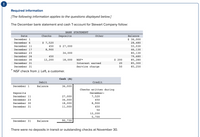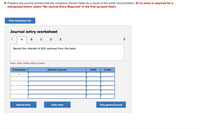
FINANCIAL ACCOUNTING
10th Edition
ISBN: 9781259964947
Author: Libby
Publisher: MCG
expand_more
expand_more
format_list_bulleted
Question

Transcribed Image Text:## Required Information
**The December bank statement and cash T-account for Stewart Company follow:**
### Bank Statement
| Date | Checks | Deposits | Other | Balance |
|--------------|--------|----------|---------------|----------|
| December 1 | | | | $36,000 |
| December 6 | $7,520 | | | 28,480 |
| December 11 | 450 | $27,000 | | 55,030 |
| December 17 | 8,900 | | | 46,130 |
| December 23 | | 34,000 | | 80,130 |
| December 26 | 450 | | | 79,680 |
| December 30 | 12,200 | 18,000 | NSF* | 85,280 |
| December 31 | | | Interest earned | 85,300 |
| December 31 | | | Service charge | 85,250 |
*NSF check from J. Left, a customer.
### Cash (A)
| | Debit | Credit |
|-----------|-------|-----------------------------------------|
| December 1 | Balance 36,000 |
| Deposits | |
| December 11 | 27,000 | Checks written during December: |
| December 23 | 34,000 | |
| December 30 | 18,000 | 7,520 |
| December 31 | 11,000 | 450 |
| | | 8,900 |
| | | 450 |
| | | 50 |
| | | 12,200 |
| | | 5,700 |
| | 90,730 | |
| December 31 | Balance |
**Note:** There were no deposits in transit or outstanding checks at November 30.

Transcribed Image Text:The image displays a section from a financial education platform, focusing on preparing journal entries for bank reconciliation. It provides step 4 of the process alongside a journal entry worksheet.
### Instructions:
4. Prepare any journal entries that the company should make as a result of the bank reconciliation. (If no entry is required for a transaction/event, select "No Journal Entry Required" in the first account field.)
### Journal Entry Worksheet:
- **Current Task:** Record the interest of $20 received from the bank.
- **Note:** Enter debits before credits.
### Worksheet Structure:
- **Tabs:** Labeled A to E, indicating different transaction entries.
- **Entry Fields:**
- **Transaction Number:** An input box labeled "1" that allows for multiple entries.
- **General Journal:** A column for recording the name of the accounts involved.
- **Debit and Credit Columns:** Clearly marked for entering the respective amounts.
### Action Buttons:
- **Record entry:** Saves the current journal entry.
- **Clear entry:** Erases all data from the current entry fields.
- **View general journal:** Opens the general ledger to review all recorded entries.
This worksheet is a crucial tool for teaching accurate recording of financial transactions in company bookkeeping.
Expert Solution
This question has been solved!
Explore an expertly crafted, step-by-step solution for a thorough understanding of key concepts.
This is a popular solution
Trending nowThis is a popular solution!
Step by stepSolved in 2 steps with 1 images

Knowledge Booster
Similar questions
- The August bank statement and cash T-account for Martha Company follow: BANK STATEMENT Date Checks Deposits Other Balance August 1 $ 13,170 August 2 $ 100 13,070 August 3 $ 9,000 22,070 August 4 200 21,870 August 5 150 21,720 August 9 490 21,230 August 10 110 21,120 August 15 3,000 24,120 August 21 200 23,920 August 24 14,900 9,020 August 25 5,500 14,520 August 30 600 13,920 August 30 Interest earned $ 20 13,940 August 31 Service charge 10 13,930 Cash (A) Debit Credit August 1 Balance 13,170 Deposits Checks written August 2 9,000 100 August 1 August 12 3,000 200 August 2 August 24 5,500 150 August 3 August 31 4,000 110 August 4 490 August 5 190 August 15 250 August 17 600 August 18 200 August 19 14,900 August 23 August 31 Balance 17,480 No deposits were in transit and no checks were…arrow_forwardHills Company's June 30 bank statement and the June ledger account for cash are summarized here: BANK STATEMENT Balance, June 1 Deposits during June Checks cleared during June Bank service charges Balance, June 30 Cash (A) Debit June 1 Checks $ 19,900 Deposits Other $ 18,800 Credit Balance 7,360 June Deposits 20,600 20,200 Checks written June June 30 Balance 7,760 $31 Balance $ 7,360 26,160 6,260 6,229 6,229 1. In addition to the balance in its bank account, Hills Company also has $420 of petty cash on hand. This amount is recorded in a separate account called Petty Cash on Hand. What is the total amount of cash that should be reported on the balance sheet at June 30?arrow_forwardSubject:- accountingarrow_forward
- Required information Skip to question [The following information applies to the questions displayed below.]The August bank statement and cash T-account for Martha Company follow: BANK STATEMENT Date Checks Deposits Other Balance August 1 $ 13,600 August 2 $ 120 13,480 August 3 $ 9,300 22,780 August 4 220 22,560 August 5 160 22,400 August 9 530 21,870 August 10 130 21,740 August 15 3,100 24,840 August 21 220 24,620 August 24 15,500 9,120 August 25 5,650 14,770 August 30 620 14,150 August 30 Interest earned $ 20 14,170 August 31 Service charge 10 14,160 Cash (A) Debit Credit August 1 Balance 13,600 Deposits Checks written August 2 9,300 120 August 1 August 12 3,100 220 August 2 August 24 5,650 160 August 3 August 31 4,100 130 August 4 530 August 5 200 August 15 280 August 17 620 August 18 220 August 19…arrow_forwardHills Company’s June 30 bank statement and the June ledger account for cash are summarized here: BANK STATEMENT Checks Deposits Other Balance Balance, June 1 $ 7,320 Deposits during June $ 18,600 25,920 Checks cleared during June $ 19,700 6,220 Bank service charges $ 31 6,189 Balance, June 30 6,189 Cash (A) Debit Credit June 1 Balance 7,320 June Deposits 20,200 20,000 Checks written June June 30 Balance 7,520 E5-5 (Algo) Part 2 Prepare any journal entries that should be made as a result of the bank reconciliation.arrow_forward
arrow_back_ios
arrow_forward_ios
Recommended textbooks for you

 AccountingAccountingISBN:9781337272094Author:WARREN, Carl S., Reeve, James M., Duchac, Jonathan E.Publisher:Cengage Learning,
AccountingAccountingISBN:9781337272094Author:WARREN, Carl S., Reeve, James M., Duchac, Jonathan E.Publisher:Cengage Learning, Accounting Information SystemsAccountingISBN:9781337619202Author:Hall, James A.Publisher:Cengage Learning,
Accounting Information SystemsAccountingISBN:9781337619202Author:Hall, James A.Publisher:Cengage Learning, Horngren's Cost Accounting: A Managerial Emphasis...AccountingISBN:9780134475585Author:Srikant M. Datar, Madhav V. RajanPublisher:PEARSON
Horngren's Cost Accounting: A Managerial Emphasis...AccountingISBN:9780134475585Author:Srikant M. Datar, Madhav V. RajanPublisher:PEARSON Intermediate AccountingAccountingISBN:9781259722660Author:J. David Spiceland, Mark W. Nelson, Wayne M ThomasPublisher:McGraw-Hill Education
Intermediate AccountingAccountingISBN:9781259722660Author:J. David Spiceland, Mark W. Nelson, Wayne M ThomasPublisher:McGraw-Hill Education Financial and Managerial AccountingAccountingISBN:9781259726705Author:John J Wild, Ken W. Shaw, Barbara Chiappetta Fundamental Accounting PrinciplesPublisher:McGraw-Hill Education
Financial and Managerial AccountingAccountingISBN:9781259726705Author:John J Wild, Ken W. Shaw, Barbara Chiappetta Fundamental Accounting PrinciplesPublisher:McGraw-Hill Education


Accounting
Accounting
ISBN:9781337272094
Author:WARREN, Carl S., Reeve, James M., Duchac, Jonathan E.
Publisher:Cengage Learning,

Accounting Information Systems
Accounting
ISBN:9781337619202
Author:Hall, James A.
Publisher:Cengage Learning,

Horngren's Cost Accounting: A Managerial Emphasis...
Accounting
ISBN:9780134475585
Author:Srikant M. Datar, Madhav V. Rajan
Publisher:PEARSON

Intermediate Accounting
Accounting
ISBN:9781259722660
Author:J. David Spiceland, Mark W. Nelson, Wayne M Thomas
Publisher:McGraw-Hill Education

Financial and Managerial Accounting
Accounting
ISBN:9781259726705
Author:John J Wild, Ken W. Shaw, Barbara Chiappetta Fundamental Accounting Principles
Publisher:McGraw-Hill Education